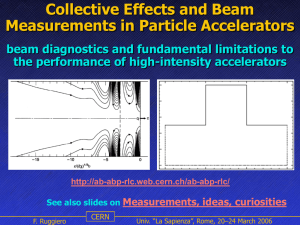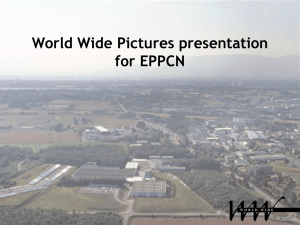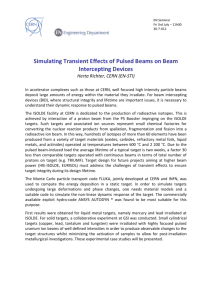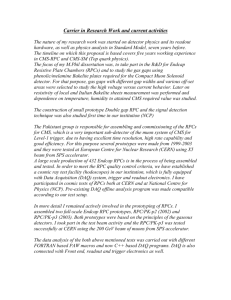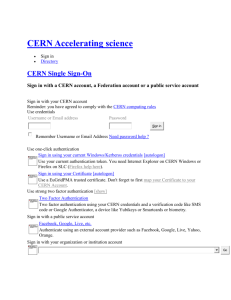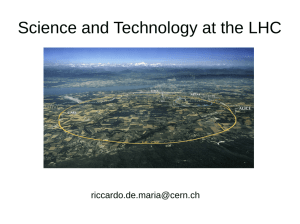CERN_MW_accel_projects_Garoby
advertisement
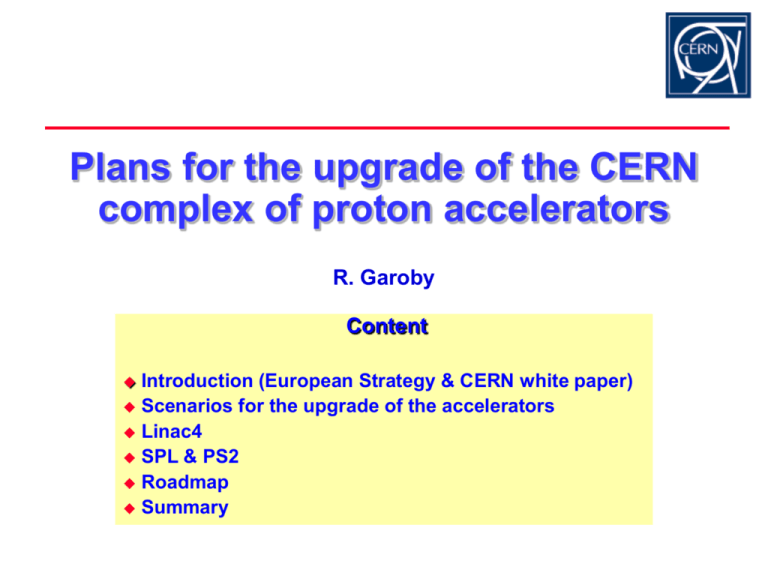
Plans for the upgrade of the CERN complex of proton accelerators R. Garoby Content Introduction (European Strategy & CERN white paper) Scenarios for the upgrade of the accelerators Linac4 SPL & PS2 Roadmap Summary Introduction INTRODUCTION R. G. 2 IDS meeting - CERN – 29 March 2007 Statement of the European Strategy Group (1/2) Consolidation and upgrade of injectors LHC upgrade and maximum performance injectors R. G. 3 IDS meeting - CERN – 29 March 2007 Statement of the European Strategy Group (2/2) R & D for LHC upgrade and n facility preparation for n facility R. G. 4 IDS meeting - CERN – 29 March 2007 “White Paper” (1/2) Submitted for information and discussion at the 139th meeting of the CERN Council (19 October 2006) Section 3: Further activities to be funded by additional resources Total request: 240 MCHF during 2008-2010 Theme 1: consolidation and basic improvements: Theme 2: renovation of the old injector complex: R & D on superconducting magnets, RF and cryogenics R & D for LHC detectors Increased support for CLIC Theme 4: miscellaneous R & D: R. G. R & D for a new PS and his injector (SPL) Construction of Linac4 Theme 3: R & D for LHC upgrade and CLIC: Basic consolidation of existing accelerators New power supply for the PS New multi-turn ejection Etc. SC RF High power target ELENA, HIE ISOLDE, 3rd phase NA-48… 5 Material (MCHF) Personnel (man.years) 103 246 55 185 58 212 41 145 IDS meeting - CERN – 29 March 2007 “White Paper” (2/2) Submitted for information and discussion at the 139th meeting of the CERN Council (19 October 2006) Section 4: Prospects over the period 2011-2016 1) 2) CLIC … 3) Infrastructure consolidation 4) R. G. 6 IDS meeting - CERN – 29 March 2007 SCENARIOS FOR THE UPGRADE OF THE ACCELERATORS R. G. 7 IDS meeting - CERN – 29 March 2007 CERN accelerator complex R. G. 8 IDS meeting - CERN – 29 March 2007 Upgrades of the accelerator complex As proposed by the PAF working group 50 MeV 160 MeV Output energy 1.4 GeV ~ 5 GeV 26 GeV 40 – 60 GeV 450 GeV 1 TeV 7 TeV ~ 14 TeV R. G. Linac2 Proton flux / Beam power Linac4 SPL’ RCPSB PSB PS SPL PS2 (PS2+) SPS LHC / SLHC 9 SPS+ DLHC SPL: Superconducting Proton Linac (~ 5 GeV) SPL’: RCPSB injector (0.16 to 0.4-1 GeV) RCPSB: Rapid Cycling PSB (0.4-1 to ~ 5 GeV) PS2: High Energy PS (~ 5 to 50 GeV – 0.3 Hz) PS2+: Superconducting PS (~ 5 to 50 GeV – 0.3 Hz) SPS+: Superconducting SPS (50 to1000 GeV) SLHC: “Superluminosity” LHC (up to 1035 cm-2s-1) DLHC: “Double energy” LHC (1 to ~14 TeV) IDS meeting - CERN – 29 March 2007 Benefits for physics STAGE 1 3 4 DESCRIPTION Linac4 PSB PS SPS Linac4 SPL PS2 or PS2+ SPS Linac4 SPL PS2 or PS2+ SPS+ Performance of LHC injectors (SLHC) + Ultimate beam from PS ++ Maximum SPS performance +++ Highest performance LHC injector Higher energy LHC - - +++ b beam - ++ (g ~100) ++ (g ~200) n Factory - +++ (~5 GeV prod. beam) +++ (~5 GeV prod. beam) k, m - ~400 kW beam at 50 GeV ~400 kW beam at 50 GeV EURISOL - +++ +++ (new accelerator) R. G. 10 IDS meeting - CERN – 29 March 2007 Layout of the new LHC injectors SPS PS2 SPL PS Linac4 R. G. 11 IDS meeting - CERN – 29 March 2007 Proton driver for a n Factory & EURISOL Connection PS2 -> TT70 SPL Accumulator & Compressor R. G. 12 IDS meeting - CERN – 29 March 2007 Possible layout of a n Factory m accelerator Target SPL m storage ring Based on CERN scheme in 2001 R. G. 13 IDS meeting - CERN – 29 March 2007 LINAC4 Technical Design Report (December 2006) CERN-AB-2006-084, http://cdsweb.cern.ch/record/1004186 L. Arnaudon, P. Baudrenghien, M. Baylac, G. Bellodi, Y. Body, J. Borburgh, P. Bourquin, J. Broere, O.Brunner, L. Bruno, C. Carli, F. Caspers, S.; Cousineau, Y. Cuvet, C. De Almeida Martins, T. Dobers, T. Fowler, R. Garoby, F. Gerigk, B. Goddard, K. Hanke, M. Hori, M. Jones, K. Kahle, W. Kalbreier, T. Kroyer, D. Küchler, A.M Lombardi, L.A López-Hernandez, M. Magistris, M. Martini, S. Maury, E.Page, M. Paoluzzi, M. Pasini, U. Raich, C. Rossi, J.P Royer, E. Sargsyan, J. Serrano, R. Scrivens, M. Silari, M. Timmins, W.Venturini-Delsolaro, M. Vretenar, R. Wegner, W. Weterings, T. Zickler R. G. 14 IDS meeting - CERN – 29 March 2007 Linac4 parameters Ion species H− Output Energy 160 MeV Bunch Frequency 352.2 MHz Max. Rep. Rate 2 Hz Beam Pulse Length 400 ms Max. Beam Duty Cycle 0.08 % Chopper Beam-on Factor 62 % Chopping scheme: 222 transmitted /133 empty buckets Source current 80 mA RFQ output current 70 mA Linac current 40 mA N. particles per pulse 1.0 × 1014 Transverse emittance 0.4 p mm mrad Max. rep. rate for accelerating structures R. G. 15 50 Hz Will re-use 352 MHz LEP RF components: klystrons, waveguides, circulators. 2 operating modes: low duty for PS Booster (PSB) injection in the first phase, high duty for the SPL in a second phase. Structures and klystrons dimensioned for 50 Hz Power supplies and electronics dimensioned for 2 Hz. IDS meeting - CERN – 29 March 2007 Linac4 topology 95keV HRF volume source (DESY) 35 kV Extrac. 60kV Postacc. RFQ 3MeV CHOPPER Radio Frequency Quadrupole (IPHI) 352 MHz 6m 1 Klystron 1 MW Total Linac4: 80 m, 18 klystrons R. G. 3MeV Chopper 352 MHz 3.6 m 11 EMquad 3 rf cavity 40MeV DTL Drift Tube Linac 352 MHz 13.4 m 3 tanks 5 klystrons 4 MW 82 PMQuad 90MeV 160MeV CCDTL SCL Cell-Coupled Drift Tube Linac 352 MHz 25.3 m 24 tanks 8 klystrons 6.5 MW 24 EMQuads Side Coupled Linac Duty cycle: 0.1% phase 1 (Linac4) 3-4% phase 2 (SPL) (design: 15%) 704 MHz 28 m 20 tanks 4 klystrons 12 MW 20 EMQuads 4 different structures, (RFQ, DTL, CCDTL, SCL) 2 frequencies current: 40 mA (avg. in pulse), 65 mA (bunch) 16 IDS meeting - CERN – 29 March 2007 The 3 MeV Test Stand In construction, first beam foreseen in 2008. - H- source (DESY type, - LEBT (2 solenoid) - IPHI RFQ - Chopper line (from CERN) - Diagnostics line (IPHI and CERN components) - Infrastructure (1 LEP Klystron, pulsed power supply, etc.) Beam quality is generated in the front-end. => Its early understanding and optimisation is fundamental for a modern linac project. R. G. 17 IDS meeting - CERN – 29 March 2007 The IPHI RFQ The 3 MeV Test Stand, Linac4 and finally SPL will use an RFQ built with IPHI technology (brazing at CERN). The RFQ is expected at CERN before the end of 2008. R. G. 18 IDS meeting - CERN – 29 March 2007 The 3 MeV chopper line Compact design 3.7 m length Dynamic range 20 – 60 mA Small e growth 4% long., 8% trans. Tolerant to alignment errors Dumping of chopped beam and collimation of unchopped beam in a conical dump structure Chopper structure: double meander strip line, 400mm length, metallized ceramic plate. 2 ns rise/fall time for bunch selectivity (352 MHz beam structure), ±500V between deflecting plates. 3 RF bunchers R. G. 19 IDS meeting - CERN – 29 March 2007 Cell Coupled DTL Used above 40 MeV: focusing periods can be longer structure with external quadrupoles, placed between short DTL-like tanks With respect to DTL: can use electromagnets, easy access and cooling, easier machining and alignment, simpler and more economic construction Modules of 3 tanks connected by coupling cells, 2 drift tubes per tank High-power prototype tested at CERN R. G. 20 IDS meeting - CERN – 29 March 2007 Beam dynamics, aperture and beam size Large apertures (>5 times rms beam size) to minimise losses. Scraping foreseen to reduce maximum beam size in presence of errors. R. G. 21 IDS meeting - CERN – 29 March 2007 SPL Conceptual Design Report (July 2006) CERN-2006-006, http://cdsweb.cern.ch/record/975366 Baylac, M; (LPSC Grenoble) Gerigk, F (ed.); Benedico-Mora, E; Caspers, F; Chel, S (CEA Saclay) ; Deconto, J M (LPSC Grenoble) ; Duperrier, R (CEA Saclay) ; Froidefond, E (LPSC Grenoble) ; Garoby, R; Hanke, K; Hill, C; Hori, M (CERN and Tokyo Univ.) ; Inigo-Golfin, J; Kahle, K; Kroyer, T; Küchler, D; Lallement, J B; Lindroos, M; Lombardi, A M; López Hernández, A; Magistris, M; Meinschad, T K; Millich, Antonio; Noah-Messomo, E; Pagani, C (INFN Milan) ; Palladino, V (INFN Naples) ; Paoluzzi, M; Pasini, M; Pierini, P (INFN Milan) ; Rossi, C; Royer, J P; Sanmartí, M; Sargsyan, E; Scrivens, R; Silari, M; Steiner, T; Tückmantel, Joachim; Uriot, D (CEA Saclay) ; Vretenar, M; R. G. 22 IDS meeting - CERN – 29 March 2007 SPL New Layout (CDR2, 2006) LINAC4 New SPL Design (CDR2, CERN Yellow Report 2006-006): Linac4 (extended to 180 MeV) + 2 superconducting sections based on 5-cell elliptical cavities at 704 MHz (INFN/CEA). Long cryomodules (LHC/TESLA-like, 12-14m), 6-8 cav./module, cold quads in cryomodules Overall length 430m (for 3.5 GeV, was 690m in previous version for 2.2 GeV) R. G. 23 Medium b High b Cavity b 0.65 1 R/Q (Ohm) 235 575 Aperture (mm) 85 90 Ep/Eacc 2.6 2.4 Eacc (MV/m) 19 25 IDS meeting - CERN – 29 March 2007 SPL Beam parameters CDR2 “slim-SPL” for SPS & LHC “MW-SPL” 3.5 4-5 5 Beam power (MW) 4 0.15 – 0.19 4-8 Rep. frequency (Hz) 50 2 50 Protons/pulse (x 1014) 1.4 1.2 1 Av. Pulse current 40 10 40 Pulse duration (ms) 0.57 1.9 0.4 Bunch frequency (MHz) 352.2 352.2 352.2 430 ~460 535 Energy (GeV) Physical length (m) 3 different designs: CDR2 (2006) based on 700 MHz high-gradient cavities “slim-SPL” for LHC (2007) with low beam power, for the needs of the LHC “MW-SPL” at higher energy, for the needs of neutrino production R. G. 24 IDS meeting - CERN – 29 March 2007 SPL cavities: elliptical, 704 MHz Elliptical cavities at b=0.5 (CEA, INFN) are giving promising results. Stiffened for pulse operation. Length ~ 0.9m Designed for 12 MV/m. cryomodule 1m 1m diagnostics, steering 10 to 15 m * Feed 4 to 6 cavities per klystron: use high power phase and amplitude modulators. R. G. 25 IDS meeting - CERN – 29 March 2007 SPL Beam Dynamics Control of losses, minimization of the emittance growth and halo development. 1) 2) 3) zero current phase advance always below 90 degrees, for stability; longitudinal to transverse phase advance ratio (with current) between 0.5 and 0.8 in order to avoid resonances smooth variation of the transverse and longitudinal phase advance per meter. 250 phase advance [deg/m] kx ky 200 kz 150 100 50 0 0 10 20 30 40 50 60 70 position [m] Smooth phase advance variation R. G. Selection of the working point (phase advances) on the Hofmann’s chart 26 IDS meeting - CERN – 29 March 2007 PS2 Working group started at end 2006 Benedikt, M; Fabich, A; Goddard, B; Hancock, S; Jowett, J; Laface, E R. G. 27 IDS meeting - CERN – 29 March 2007 Justifications of PS2 Assure high reliability and availability of injector chain for LHC operation Replace the PS ! Increase performance of injector chain for LHC operation Higher beam brightness by more favourable energy range Shorter filling time by improved cycling schemes Improve performance for other physics applications in energy range PS to SPS (10 to 450 GeV). Prepare long-term (energy) upgrade of complete accelerator chain R. G. PS main magnet coils and laminations Rotating machine main power converter Higher PS2 ejection energy to reduce SPS+ energy swing 28 IDS meeting - CERN – 29 March 2007 PS2 design goals Beam brightness for LHC: Reach twice brightness of the ultimate 25 ns LHC beam (20% reserve for losses): 4.01011 per LHC bunch (inst. 1.71011) “Ultimate“ bunches at 12.5 ns, twice ultimate at 25ns, etc. Significantly higher injection energy into SPS (~50 GeV). Injection into SPS well above transition energy Reduced space charge at SPS injection Smaller transverse emittances and reduced losses Potential for long-term SPS replacement with higher energy. Ejection energy determines PS2 machine size As versatile as existing PS R. G. Determines average line density in the machine at injection and therefore the injection energy via incoherent SC tune spread. Protons, ions, high intensity physics beams, slow extraction, etc. 29 IDS meeting - CERN – 29 March 2007 Considerations on PS2 size Existing PS with 25 GeV top energy: Combined function magnets with classical lattice. Bending radius of 70 m (~440 m length) (B = 1.25 T at 25 GeV) 114 m (174 m) of (fully used) straight sections. Average radius 100 m and machine circumference 628 m. PS2: extraction energy ~50 GeV (NC) Separated function (eventually complicated lattice for imag. gt) Assume quads will occupy 30 % of integrated dipole length NC: dipole at ~ 1.8 T (i.e. bending radius ~100 m, length ~ 630 m) Additional space for quadrupoles: ~200 m Larger space requirements for insertions: ~300m PS2 will have ~twice PS radius i.e. 200 m and 1250 m length R. G. 30 IDS meeting - CERN – 29 March 2007 Considerations on PS2 injection energy Incoherent space charge tune spread at injection: Existing PS with 1.4 GeV injection energy just capable of producing the ultimate LHC beam (DQv ~-0.3) DQS.C. Nb 1 1 2 en bg B b Bb… bunching factor (average / peak density for single bunch) Bb will decrease by factor 2 when putting the same bunch in a machine with twice larger circumference (DQ increases with R)! PS2: twice ultimate brightness in a twice larger machine 4 times larger incoherent tune spread at given energy. Compensation with ratio bg2 at injection: R. G. Minimum injection energy PS2: 3.5 to 4 GeV 31 bg 2 PS 2 4 bg 2 PS IDS meeting - CERN – 29 March 2007 PS2 preliminary parameters PS PS2 3.5 – 4.0 1.4 ~ 50 13/25 ~ 1346 628 Maximum intensity LHC (25ns) (p/b) 4.0 x 1011 1.7 x 1011 Maximum intensity for fixed target physics (p/p) 1.2 x 1014 3.3 x 1014 1000 70 1.5 2.2 ~ 2.5 1.2/2.4 400 60 Injection energy kinetic (GeV) Extraction energy kinetic (GeV) Circumference (m) Maximum energy per beam pulse (kJ) Max ramp rate (T/s) Repetition time at 50 GeV (s) Max. effective beam power (kW) R. G. 32 IDS meeting - CERN – 29 March 2007 ROADMAP R. G. 33 IDS meeting - CERN – 29 March 2007 Linac4 project 2007 mid-2007 July September 2007 R. G. Progressive beam commissioning of Linac4 Mid-2011 Start of Civil Engineering Start of construction of Linac4 equipment Mid-2010 Project review Project organization inside CERN January 2008: official start of the Linac4 project Finalization of the design (updated design report) Conclusion on allocation of work packages / distribution of « remaining » tasks inside CERN Market survey for Civil Engineering September December 2007 Optimization of the layout on the CERN site Negotiation of detailed work packages with external partners CERN Council decision on the « White paper » PSB stop for modification PSB beam commissioning Beginning 2012: PSB operational for physics with Linac4 34 IDS meeting - CERN – 29 March 2007 Preparation for the SLHC end 2010 for LHC and SPS Selection of the most promissing scenarios for the LHC upgrade Experience with the LHC and its practical limitations… Detailed technical design of the LHC upgrade Detailed technical design of the SPS upgrade Prototyping of critical components Detailed estimates of the necessary resources Negotiation with external contributors end 2010 for the injectors of SPS Optimization of the layout on the CERN site Optimization of compatibility with other users (EURISOL, n’s, pbars, heavy ions…) Detailed technical design Prototyping of critical components Detailed Civil Enginering drawings Detailed estimates of the necessary resources Negotiation with external contributors publication of Technical Design Reports with resources estimates R. G. 35 IDS meeting - CERN – 29 March 2007 Implementation of the LHC luminosity upgrade 2011 2015 for LHC and SPS 2011 2015 for the injectors of SPS Construction of SPL and PS2 Progressive beam commissioning of SPL Beam commissioning of PS2 2016 R. G. Construction of components for the LHC and SPS upgrade Progressive modification of the SPS (vacuum chamber treatment, impedance reduction etc.) Connection of PS2 to SPS & final modifications of the SPS (injection system etc.) Beam commissioning of the SPS Beam commissioning of the LHC 36 IDS meeting - CERN – 29 March 2007 Planning of the new injectors 3 MeV test place ready Linac4 approval CDR 2 SPL & PS2 approval R. G. 37 IDS meeting - CERN – 29 March 2007 SUMMARY R. G. 38 IDS meeting - CERN – 29 March 2007 CERN is soon going to commission the largest and most sophisticated particle accelerator ever built. Such an installation must be fully exploited. It is time to prepare for securing its operation, increasing the reliability of all the infrastructure for protons and ions. It is time to develop solutions for pushing performance to the limit. It is a unique opportunity to plan new accelerators that can satisfy a new generation of physics experiments. Mid-2007 is a first crucial milestone in an overall planning that should last for a decade. R. G. 39 IDS meeting - CERN – 29 March 2007
